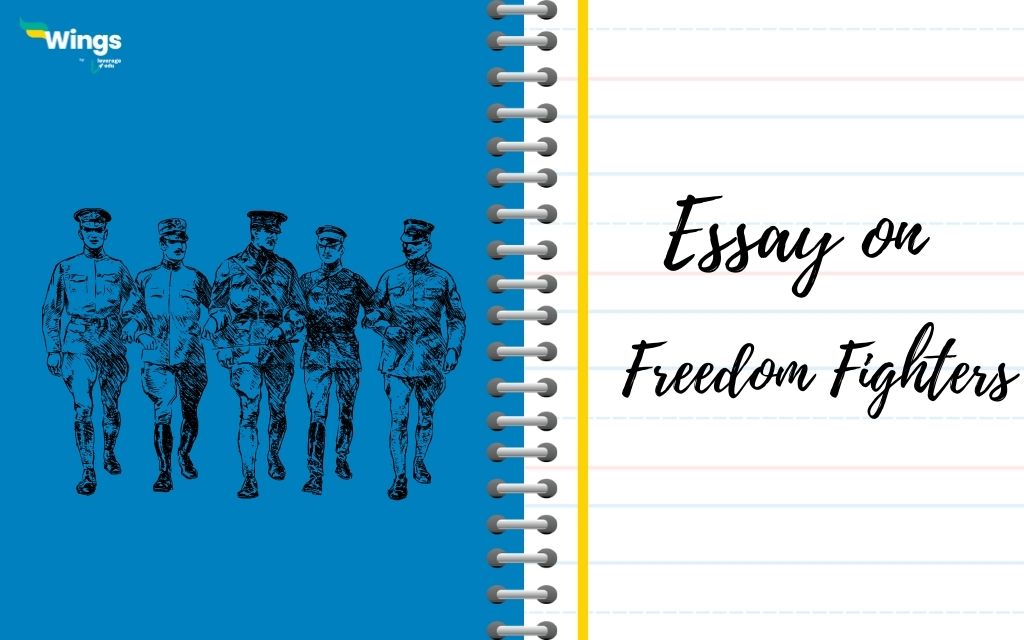Essay on Freedom Fighters: Indian Freedom fighters are often referred to as the backbone of India’s freedom struggle for independence. India was a British for almost two centuries; from the Battle of Buxar in 1764 to the Cabinet Mission Plan in 1946. During this long span of 2 centuries, several freedom fighters emerged at the forefront and fought for the country’s independence and against social evil practices.
Freedom fighters are often known for their courage and determination, their undying willpower for the country’s independence and their commitment to justice and equality. Such ideals are important for every human being, as they not only make us a responsible citizen but also serve as an opportunity to work towards nation-building. Today, we will list down some essay on freedom fighters which will help students with their overall knowledge about them.
Master the art of essay writing with our blog on How to Write an Essay in English.
Contents
Significance of Freedom Fighters in Indian Culture
Indian history has a lot of tales and stories about sacrifice, and love for the country through these freedom fighters. The importance of these freedom fighters dates back to the revolutionary days.
They are responsible for restoring the country’s independence and also represent the struggles and aspirations of the people of the country. The untold stories told by them depict courage and determination and also share the identity sense and pride of their betterment and courage.
Freedom fighters fought not just for political freedom, but for a society founded on equality and justice. The significance of freedom fighters in Indian culture is immeasurable.
Also Read: Essay On Subhash Chandra Bose for Students
Essay on Freedom Fighters in 100 Words
Freedom fighters in Indian culture are brave heroes who fought for our country’s freedom from British rule. They include Mahatma Gandhi, who used peaceful protests, and Bhagat Singh, who stood up against injustice.
These fighters are symbols of courage and determination. They teach us about unity and different values for the country.
Their sacrifices for the country also inspire and make us feel proud of their heritage and also stand up against oppression. In Indian culture, they’re like guiding stars, reminding us that even a single person’s actions can bring about big changes for the better.
Essay on Freedom Fighters in 200 Words
Freedom fighters hold a special place in Indian culture. They were brave individuals who fought against British rule to gain independence. They have also displayed undeniable courage and determination for the country.
Mahatma Gandhi, known as the “Father of the Nation,” led the nonviolent movement against British rule. His life principles were inspired by non-violence and truth. He led many peaceful protests in the country.
Another brave soul was Bhagat Singh, who fearlessly stood up against injustice. His sacrifice and dedication continue to inspire generations.
These freedom fighters are like role models in Indian culture. They teach us the importance of unity, sacrifice, and patriotism. With time, these stories have inspired and made an impact on people’s lives.
Their legacy lives on in India’s cultural fabric through literature, movies, and monuments. To remember the struggle and principles of this Independence Day, we celebrate Independence Day every year. In Indian culture, these personalities are symbols of courage and hope and also remind ordinary people of their courage and values.
Also Read: Holi Essay: Free Sample Essays 100 To 500 Words In English
Essay on Freedom Fighters in 1000 Words
Freedom fighters are the backbone of any nation’s struggle for independence. In India, freedom fighters played a crucial role in freeing the country from British rule. They came from different religions, regions, and social backgrounds. Their sacrifices gave us the freedom we enjoy today.
India was under British rule for nearly 200 years. During this time, Indians faced exploitation, injustice, and poverty. Freedom fighters stood up against these wrongs. They dreamed of a free and independent India. Their courage and determination united the nation.
Many freedom fighters came from ordinary families. They did not seek fame or fortune. They fought because they wanted a better future for all. Men and women alike took part in the freedom struggle. People from different religions and social classes joined hands to fight for independence.
Early Struggles for Freedom
The first major uprising against British rule was the Revolt of 1857. It was also called the First War of Independence. Leaders like Rani Lakshmibai, Mangal Pandey, and Bahadur Shah Zafar led the charge. Rani Lakshmibai fought bravely in battle. Mangal Pandey led a revolt among Indian soldiers. Although the revolt failed, it inspired future generations.
In the late 19th century, leaders like Dadabhai Naoroji and Gopal Krishna Gokhale spread awareness about British exploitation. They used peaceful methods to demand justice. They believed in using education and dialogue to bring change.
The Non-Cooperation Movement
Mahatma Gandhi led the Non-Cooperation Movement in 1920. He asked people to stop cooperating with the British. Indians boycotted British goods, schools, and courts. This peaceful protest shook the British Empire. People from all walks of life joined the movement. Women like Sarojini Naidu also played an important role. They gave speeches and inspired others to fight peacefully.
The Role of Revolutionaries
Not all freedom fighters believed in non-violence. Some believed that only armed struggle could free India. Bhagat Singh, Chandrashekhar Azad, and Sukhdev were among them. They carried out daring acts to protest against British injustice. Bhagat Singh and his comrades were hanged, but their bravery inspired millions.
Women Freedom Fighters
Women played a crucial role in the freedom movement. Sarojini Naidu was a poet and a political leader. She became the first woman to serve as President of the Indian National Congress. Kasturba Gandhi worked alongside her husband, Mahatma Gandhi. She led protests and helped women join the movement. Aruna Asaf Ali was known for hoisting the Indian flag during the Quit India Movement in 1942.
Freedom Fighters from Different Regions
Freedom fighters came from every corner of India. In Bengal, Subhas Chandra Bose formed the Indian National Army (INA). He believed in fighting the British through armed force. In the South, V.O. Chidambaram Pillai challenged British trade monopolies. In Punjab, Lala Lajpat Rai protested against the British and suffered fatal injuries during a protest.
In the Northeast, Rani Gaidinliu fought against British rule and was imprisoned for years. From Gujarat, Sardar Vallabhbhai Patel led the people in civil disobedience. Their collective efforts united the nation.
The Partition and Unity
The freedom struggle did not end with independence. After 1947, India faced the challenge of partition. Millions of people were displaced. Freedom fighters like Mahatma Gandhi worked tirelessly to maintain peace. Sardar Patel united over 500 princely states into one nation. Their efforts laid the foundation for a united and democratic India.
Methods of Fighting for Freedom
Freedom fighters used various methods to resist British rule. Some followed non-violence and civil disobedience. Others chose armed rebellion. Some wrote newspapers and books to spread awareness. Others led protests and strikes. Every method had one goal—freedom from British rule.
Gandhi’s method of non-violence was powerful. It united people across caste, religion, and gender. Revolutionaries like Bhagat Singh believed in direct action. Both approaches played a role in India’s independence.
Legacy of Freedom Fighters
The sacrifices of freedom fighters gave us independence on August 15, 1947. Their struggle also gave us democracy. The Indian Constitution, adopted in 1950, reflects their vision of justice, equality, and freedom.
Dr. B.R. Ambedkar played a vital role in shaping independent India. He was the chief architect of the Indian Constitution. He fought for the rights of marginalised communities and worked to eliminate caste-based discrimination. His contributions ensured that independent India would be a nation where everyone had equal rights and dignity.
Their legacy continues to inspire us. They taught us to stand against injustice. They showed that unity can overcome oppression. Without their sacrifices, India would not be a free and democratic nation.
Conclusion
Freedom fighters came from all walks of life. They belonged to different regions, religions, and classes. Yet, they shared a common dream—a free India. Their courage and sacrifice gave us the freedom we enjoy today. It is our duty to honour their legacy by protecting our democracy and working for a better future.
FAQs
Freedom fighters have a lot of importance in every country. They are important for restoring the country’s culture and also preserving the heritage.
Some of the prominent freedom figures in the country are Netaji Subash Chandrabose, Mahatma Gandhi, and Bhagat Singh.
The most prominent freedom movements in history are the Civil Disobedience Movement, Khilafat, and Non-Coorporation Movement.
Related Articles
For more information on such interesting topics, visit our essay writing page and follow Leverage Edu.
 One app for all your study abroad needs
One app for all your study abroad needs














